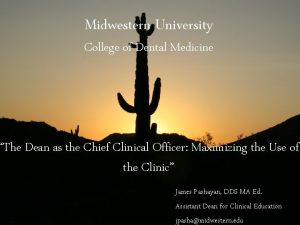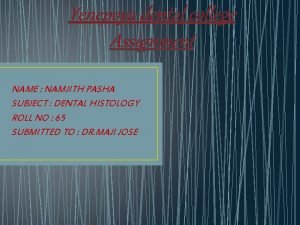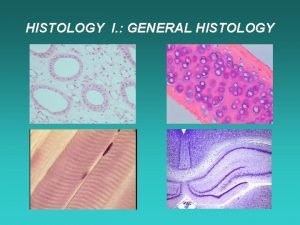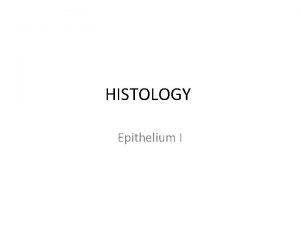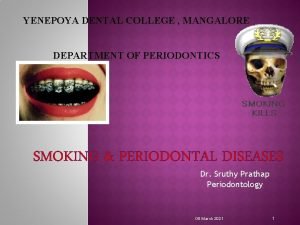YENEPOYA DENTAL COLLEGE DENTAL HISTOLOGY ASSIGNMENT NAME HANEENA











- Slides: 11

YENEPOYA DENTAL COLLEGE DENTAL HISTOLOGY ASSIGNMENT NAME : HANEENA ROLL NO: 33 SUBMITTED TO : DR. MAJI JOSE SUBMITTED ON : 19 -3 -2013

TOPIC : CHANGES IN EPITHELIAL CELL JUNCTION AND BASEMENT MEMBRANE IN PEMPHIGUS

PEMPHIGUS Pemphigus is a rare group of blistering autoimmune diseases that affect the skin and mucous membranes. In pemphigus, autoantibodies form against desmoglein. Desmoglein forms the "glue" that attaches adjacent epidermal cells via attachment points called desmosomes. When autoantibodies attack desmogleins, the cells become separated from each other and the epidermis becomes "unglued", a phenomenon called acantholysis. .

This causes blisters that slough off and turn into sores. In some cases, these blisters can cover a significant area of the skin. Originally, the cause of this disease was unknown, and "pemphigus" was used to refer to any blistering disease of the skin and mucosa

TYPES OF PEMPHIGUS There are several types of pemphigus which vary in severity: pemphigus vulgaris, pemphigus foliaceus, Intraepidermal neutrophilic Ig. A dermatosis, and paraneoplastic pemphigus. Ø Pemphigus vulgaris (PV - ICD-10 L 10. 0) is the most common form of the disorder and occurs when antibodies attack Desmoglein 3. Sores often originate in the mouth, making eating difficult and uncomfortable. Although pemphigus vulgaris may occur at any age, it is most common among people between the ages of 40 and 60. It is more frequent among Ashkenazi Jews. Rarely, it is associated with myasthenia gravis. Nail disease may be the only finding and has prognostic value in management

Ø Pemphigus foliaceus (PF) is the least severe of the three varieties. Desmoglein 1, the protein that is destroyed by the autoantibody, is only found in the top dry layer of the skin. PF is characterized by crusty sores that often begin on the scalp, and may move to the chest, back, and face. Mouth sores do not occur. It is not as painful as pemphigus vulgaris, and is often misdiagnosed as dermatitis or eczema. Ø Intraepidermal neutrophilic Ig. A dermatosis is characterized histologically by intraepidermal bullae with neutrophils, some eosinophils, and acantholysis.

Ø The least common and most severe type of pemphigus is paraneoplastic pemphigus (PNP). This disorder is a complication of cancer, usually lymphoma and Castleman's disease. It may precede the diagnosis of the tumor. Painful sores appear on the mouth, lips, and the esophagus. In this variety of pemphigus, the disease process often involves the lungs, causing bronchiolitis obliterans (constrictive bronchiolitis). Complete removal and/or cure of the tumor may improve the skin disease, but lung damage is generally irreversible.

CHANGES IN EPITHELIAL CELL JUNCTIONS IN PEMPHIGUS If the connecting adjacent epithelial cells of the skin are not functioning correctly, layers of the skin can pull apart and allow abnormal movements of fluid within the skin, resulting in blisters and other tissue damage. Blistering diseases such as Pemphigus vulgaris and Pemphigus foliaceus are autoimmune diseases in which auto-antibodies target the proteins desmoglein 3 and desmoglein 1 respectively. The symptoms of the diseases are caused by the subsequent disruption to the desmosome-keratin filament complex leading to a breakdown in cell adhesion

CHANGES IN BASEMENT MEMBRANE IN PEMPHIGUS Transudative fluid accumulates in between the keratinocytes and basement membrane (suprabasal split), forming a blister and resulting in what is known as a positive Nikolsky's sign. This is a contrasting feature from bullous pemphigoid, where the detachment occurs between the epidermis and dermis (subepidermal bullae).

DIAGNOSIS Pemphigus is recognized by a dermatologist from the appearance and distribution of the skin lesions. The pathologist looks for an intraepidermal vesicle caused by the breaking apart of epidermal cells (acantholysis). Thus, the superficial (upper) portion of the epidermis sloughs off, leaving the bottom layer of cells on the "floor" of the blister. This bottom layer of cells is said to have a "tombstone appearance". Definitive diagnosis also requires the demonstration of anti-desmoglein autoantibodies by direct immunofluorescence on the skin biopsy. These antibodies appear as Ig. G deposits along the desmosomes between epidermal cells, a pattern reminiscent of chicken wire. Antidesmoglein antibodies can also be detected in a blood sample using the ELISA technique.

THE END
 Nephritis
Nephritis Yenepoya physiotherapy college
Yenepoya physiotherapy college Yengage notes
Yengage notes Name three lines
Name three lines Midwestern university college of dental medicine
Midwestern university college of dental medicine Madison college dental clinic
Madison college dental clinic Asd college college readiness program
Asd college college readiness program Early college high school at midland college
Early college high school at midland college Name the members of the dental healthcare team
Name the members of the dental healthcare team Where does sveta popova study
Where does sveta popova study Author surname and initials example
Author surname and initials example Name above every other name
Name above every other name




